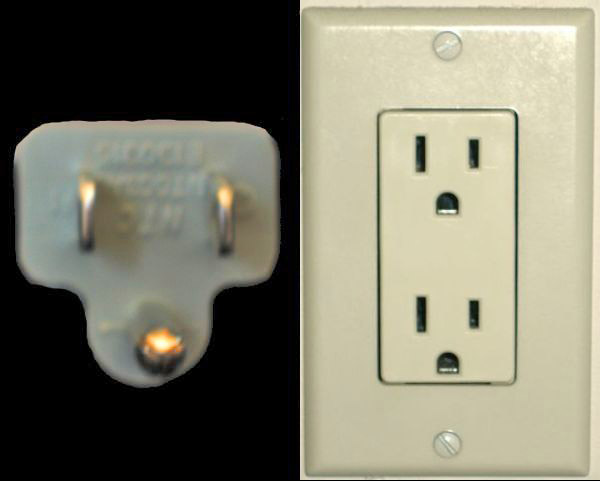
Where found:
American Samoa, Anguilla, Antigua, Aruba,
Bahamas, Bangladesh, Barbados, Bermuda, Bolivia, Brazil, Cambodia, Canada,
Cayman Islands, China (without holes in blades and slightly shorter
blades), Colombia, Costa Rica, Cuba, Ecuador, El Salvador, Guam,
Guatemala, Guyana, Haiti, Honduras, Jamaica, Japan, Laos, Lebanon,
Liberia, Maldives, Mexico, Micronesia, Montserrat, Netherlands Antilles,
Nicaragua, Niger, Okinawa, Panama, Peru, Philippines, Puerto Rico, St.
Vincent, Saudi Arabia, Tahiti, Taiwan, Thailand, United States, Venezuela,
Vietnam, Virgin Islands (U.S.& British), Yemen.
Commentary:
- This plug and receptacle are technically
known as NEMA 1-15 (North American 15 A/125 V
ungrounded).
Standardized by the U.S. National
Electrical Manufacturers Association[7] and
adopted by 38 other countries, this simple plug with two flat parallel
pins, or blades, is used in most of North America and on
the east coast of South America on
devices not requiring a ground connection, such as lamps and
"double-insulated" small appliances. NEMA 1-15 sockets have been
prohibited in new construction in the United States and Canada since 1962,
but remain in many older homes and are still sold for replacement use
only. Type A plugs are still very common because they are compatible with
type B sockets.
Early designs could be inserted either way, but
some modern plugs make the neutral blade wider than the live blade; so
that a polarized plug can be inserted only one way. New polarized
plugs will not fit in old type A sockets, but both old and new type A
plugs will fit in new type A and type B sockets.
- A similar plug and receptacle commonly
foundin Japan is technically known as JIS C 8303, Class II (Japanese
15 A/100 V ungrounded).
The Japanese plug and socket are identical to
NEMA 1-15. However, the Japanese system incorporates stricter
dimensional requirements for the plug housing, different marking
requirements, and mandatory testing and approval by Japanese standards
agencies.
Some older Japanese outlets and multiplug
adapters are non-polarized -- the slots in the sockets are the same size -
and will only accept non-polarized plugs. Japanese plugs should be able to
fit into modern North American outlets without trouble, but North American
appliances with polarized plugs may require adapters or replacement
non-polarized plugs to connect to older Japanese outlets; or even
replacement of the wall socket itself.
Type B - North American
3-pin
Flat blades with round
grounding pin

Where found:
All of the above noted for Type A except Bangladesh, Bolivia, Cambodia, China, Dominican Republic, Korea,
Liberia, Maldives, Peru, St. Vincent, Tahiti, Thailand, Vietnam,
Yemen.
Also found in Azores, Belize, Trinidad and Tobago.
Commentary:
- This plug and receptacle are technically
known as NEMA 5-15 (North American 15 A/125 V grounded)
The type B plug has two flat parallel blades
like type A, but has a round ground or earth pin. It is rated for 15
amperes at 125 volts. The ground pin is longer than the live and neutral
blades, so the device is grounded before the power is connected. The
neutral blade in the Type B socket is wider than the live one to prevent
polarized Type A plugs being inserted incorrectly. Type B plugs often
have both pins narrow since the ground pin enforces polarity.
Looking directly at a type B outlet with the
ground at the bottom, the neutral slot is on the left, and the live slot
is on the right. They may be installed with the ground at the top or on
either side. In new residential construction since about 1992, a 20-amp
receptacle with a T-slot for the neutral blade allows either 15-ampere
parallel blade plugs or 20-ampere plugs to be used.
Japan also uses a Type B plug similar to the
North American one. However, it is less common than its Type A
equivalent.
|

